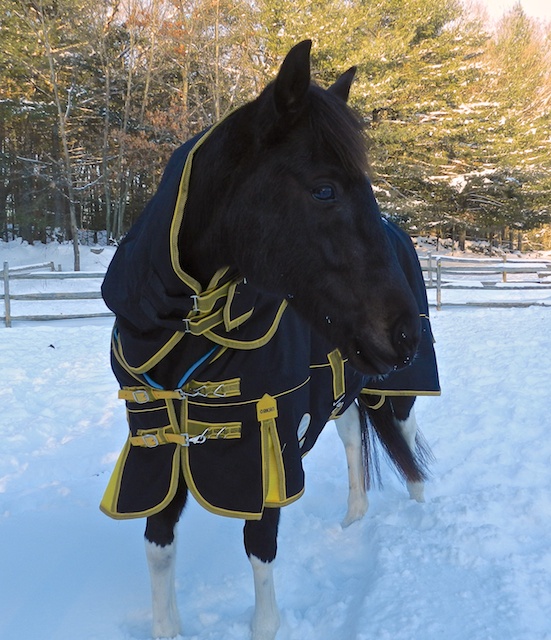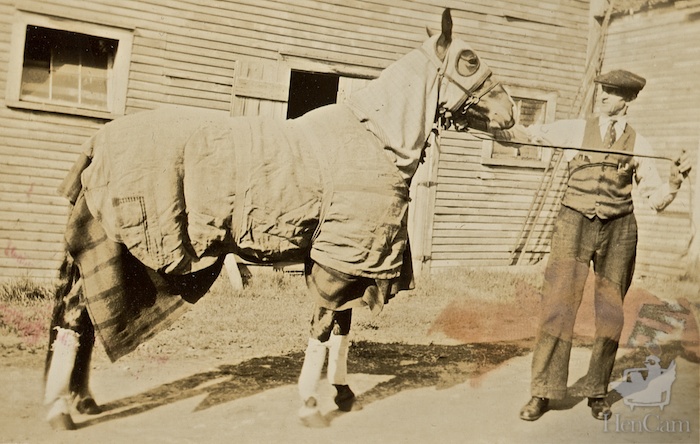Even with temperatures going into the minus teens overnight, I am unwavering about not hanging heat lamps in the coops. However, I do take an extra step to keep my horse warm. Tonka lives out in a paddock, both day and night. There’s a shed that he can go into for shelter from the wind. He has a fur coat, which is thick, but not as warm as my hens’ down jackets. Although Tonka and his pasture-mate Merlin (a pleasant Standarbred gelding) might stand side-by-side to ward off wind, they don’t cuddle up like the chickens do. Some horses grow dense coats and can tolerate most any storm. Although Tonka’s coat is not as thin as that of a Thoroughbred that I once owned (she really needed coddling in winter), he does have to wear a blanket when it’s below freezing. And when the temps dip down below 0°, I dress him in this bit of horse armor:
Lest you think that putting coats on horses is a new, indulgent phenomena, take a look at this one-hundred year-old photograph from my collection:
It does make me feel less indulgent about blanketing my own horse.
By the way, I don’t know why this horse is clothed the way he is. Judging by the handler’s apparel, it’s not cold out. Does anyone know?



Looking at the lower leg wrappings, it might be that this horse was involved in racing (also the head gear).
When I first saw this, I imagined the Marx Brothers and that racehorse from the brilliant movie, “A Day At the Races.”
Also, the tail is wrapped…..possibly harness racing
he’s going to a fair to show ..?
He probably is a show horse and they don’t want his coat to fade from the sun.
My guess would be he is being trailered somewhere (head and tail protection, plus the leg wraps), and the trailer –or, given the time period, perhaps an open truck– might be a more open design. Even 50 or 60 degree days can chill a horse pretty badly at 50 miles per hour.
Tracy, that must be it!
I was thinking that also!
Too early for a truck – but horses were transported via rail cars.
I’ll ditto Tracy above and add that that this also could be a cool down session. If your horse is hot and sweaty and it is cold or cool windy weather you throw a heavy blanket on for the early stages of cool down. And then, as you walk them out, you put increasingly lighter blankets on till the horse is cool and dry. Wraps are sometimes left on for a bit if the horse is prone to fluid build up after exercise.
He looks to be a race or show horse, hence the leg wraps. Also, show horses have for a long time been sheeted and neck wrapped to keep their coat short, sleek, clean. Sometimes the use of neck “sweats” have been used to keep the neck of the horses “slender”. This horse could have just had a hard work out and is very sweaty, hence the “cooler”, another possibility.
You’ve done a good thing by providing your horse with winter gear, as he lives outside for the most part. I think if we can go the extra step to ensure their comfort, why ever not.
Sometimes that extra step sounds right to us humans, but isn’t right for the animals – which is why I don’t heat the coops. We might think that heat would be good, but it’s actually detrimental the flock’s health. Horses with thick coats can sweat with blankets on, and that is bad for their health. Blankets can chafe, and limit mobility. Tonka is getting the worst case of dandruff! And when I take it off to groom him, he gets static electricity shocks (poor guy!) Tonka isn’t clipped, and his fur coat has grown in, so, if it’s not raining or snowing, and if the temp get up in the 20s, he goes au natural.
Terry, forgive me if you already know this tip. One way to eliminate (or minimize) the static electricity in the winter without adding anything that will strip the natural oil from a horse’s coat is to apply a very light coat of Show Sheen to them. Most products like this are actually silicone based. While I’m not a fan of coating a horse in silicone, it’s very helpful in eliminating the little grooming ‘shocks’ that can become an unintended training experience for the horse –making him or her try to avoid being groomed or handled over time, but doesn’t strip any oil or inhibit the oil from protecting the animal.
Another approach is to soak a rag in Argon Oil/water solution, wring it out and just lightly wipe the horse down. Helps with static electricity, helps with dry skin, and gets absorbed quite quickly.
I’m sure you know a million of these tips, but the Argon Oil is great stuff.
Best, Tracy
P.S. So sorry about Twinky Dink, but as you say, she died without fear or stress. A gift.
I didn’t know that trick about show sheen! Will try it today!
I had to look that one up (wondering if it could be used on cats when the weather turns dry and they crackle with static!) and I found a neat bit on Wikipedia about argan oil, but not a whole lot about argon oil. Are they the same thing? Wouldn’t any edible oil dampen static?
One of your chickens seems to be trying to get back in the coop and keeps falling, please check on her. Hope you see this soon.
Yes, she has been outside for quite a while, I think it’s Twinkydink
Thank you for your concern. Yes, it is Twinkydink. To be blunt, she is dying. She has chosen her place – her favorite spot in the pen. I am letting her be. She’s not suffering, she’s just petering out. I’ll be writing more about this later this week.
Good for her! No one is going to tell her when or where to take her last breathe. She will do it her way.